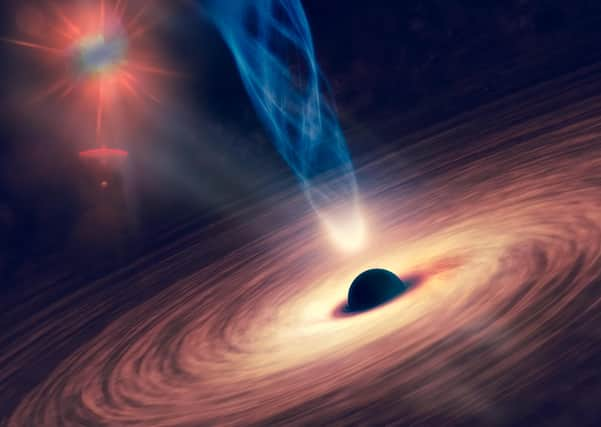Scottish scientists prove decades-old black hole theory


Scientists at the University of Glasgow’s School of Physics and Astronomy set out to validate Roger Penrose’s 1969 work. They used sound waves in an attempt to endorse the “extremely odd physics a half-century after the theory was first proposed”.
British physicist Mr Penrose theorised that energy could be created by dropping objects such as a rocket into a black hole and splitting the object in two. By retrieving one half, the recoil action would then gain energy due to the black hole’s rotation, he said.
Advertisement
Hide AdAdvertisement
Hide AdHe theorised the energy could be stored and used to power entire worlds, but Mr Penrose said the engineering challenge posed by the experiment could only be carried out by an advanced, possibly alien, civilisation. In 1971, physicist Yakov Zeldovich suggested the theory could be tested with twisted light waves projected onto a spinning surface.
To test that, the spinning surface would need to rotate at at least a billion times a second – a feat still not possible due to the limitations of engineering.
Now, the Glasgow researchers have finally found a way to experimentally demonstrate the effect using sound waves, which require a much slower rotating surface.
Using a ring of speakers, the researchers sent a rotating wave of sound towards a spinning foam disk.
Attached to the back of the disk were two microphones, which found that as the sound waves passed through the disk, the pitch was amplified by up to 30 per cent, known as a rotational Doppler effect.
Marion Cromb, the paper’s lead author, said: “The linear version of the Doppler effect is familiar to most people. The phenomenon occurs as the pitch of an ambulance siren appears to rise as it approaches the listener, but drops as it heads away.
“It appears to rise because the sound waves are reaching the listener more frequently as the ambulance nears, then less frequently as it passes.”
She added: “The rotational Doppler effect is similar, but the effect is confined to a circular space. The twisted sound waves change their pitch when measured from the point of view of the rotating surface.
Advertisement
Hide AdAdvertisement
Hide Ad“If the surface rotates fast enough then the sound frequency can do something very strange. It can go from a positive frequency to a negative one, and in doing so steal some energy from the rotation of the surface.” During the experiment, researchers found that as the pitch of the sound wave hits the spinning disk, it dropped until it became too low to hear.
Comments
Want to join the conversation? Please or to comment on this article.